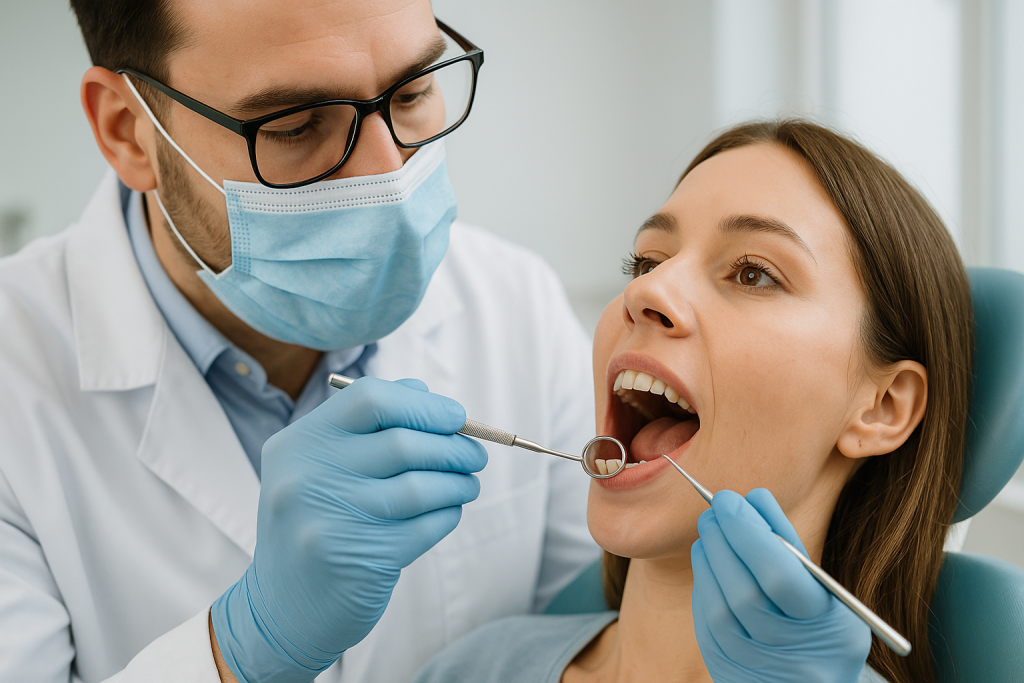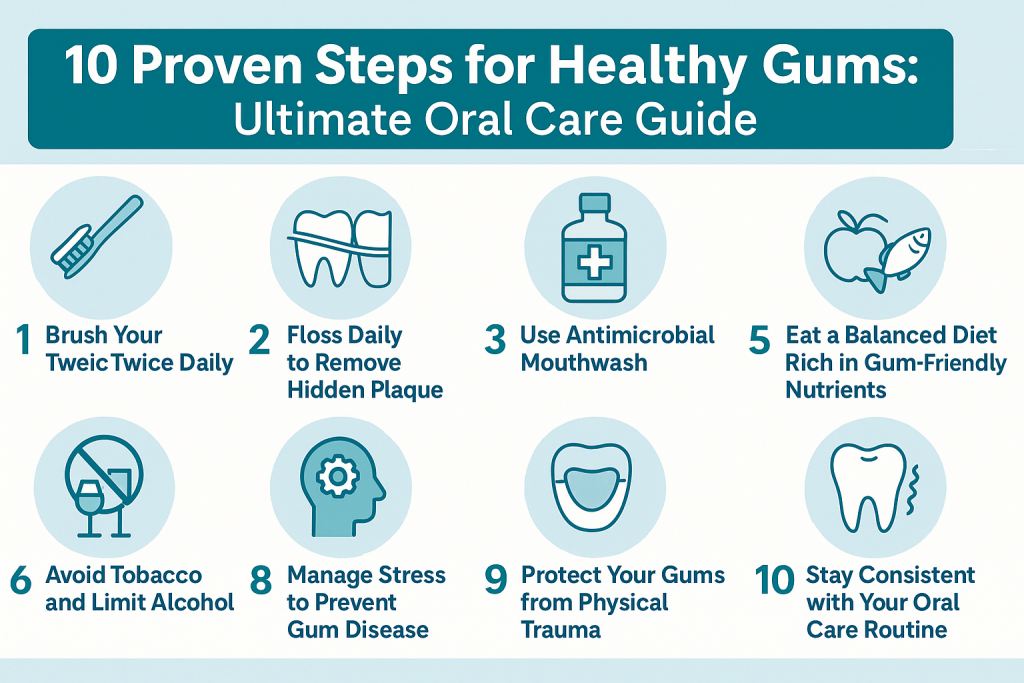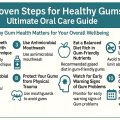Why Gum Health Matters for Your Overall Wellbeing
Many people focus on keeping their teeth clean but overlook the critical role gum health plays in oral wellness. Unhealthy gums can lead to gum disease, tooth loss, bad breath, and even impact your overall health, including heart disease and diabetes. Prioritizing gum care is essential for a bright smile and strong teeth.
Studies show that nearly half of adults over age 30 experience some form of periodontal disease. Early signs like redness, swelling, or bleeding should not be ignored. By following simple, effective strategies, you can maintain healthy gums and reduce the risk of dental complications.
10 Effective Steps to Keep Your Gums Healthy
Here are the top 10 expert-endorsed steps for achieving and maintaining healthy gums. These actionable tips are easy to integrate into daily life for lasting results.
1. Brush Your Teeth Twice Daily with the Right Technique

Brushing is the foundation of good oral care, but technique matters. Use a soft-bristled toothbrush and fluoride toothpaste to gently clean your teeth and gum line. Brush for at least two minutes, making sure to reach all areas, including the front, back, and chewing surfaces.
- Hold your brush at a 45-degree angle to your gums.
- Use short, gentle strokes to avoid damaging gum tissue.
- Replace your toothbrush every 3–4 months or sooner if the bristles fray.
2. Floss Daily to Remove Hidden Plaque

Flossing removes plaque and food particles that brushing alone can’t get rid of, especially between teeth and under the gum line. Regular flossing is proven to reduce gum inflammation and prevent gum disease.
- Use about 18 inches of floss, winding most around your middle fingers.
- Gently slide the floss between teeth and curve it against each tooth in a ‘C’ shape.
- Move the floss up and down, avoiding snapping into gums.
3. Use Antimicrobial Mouthwash
An antimicrobial or therapeutic mouthwash can help reduce harmful bacteria, freshen breath, and lower your risk of gum problems. Look for a mouthwash containing active ingredients like chlorhexidine, cetylpyridinium chloride, or essential oils.
Rinse for 30 seconds after brushing and flossing. Mouthwash is not a substitute for brushing or flossing, but an excellent addition to your routine.
4. Regular Dental Checkups and Professional Cleanings

Visiting your dentist every six months allows for early detection of gum disease, tartar buildup, and other oral health issues. Professional cleanings remove hardened plaque (calculus) that brushing and flossing cannot, keeping your gums healthy.
- Schedule appointments at least twice a year.
- Discuss any gum sensitivity, bleeding, or changes with your dentist.
- Ask for personalized advice on your gum care routine.
5. Eat a Balanced Diet Rich in Gum-Friendly Nutrients

Your diet directly impacts your gum health. Foods high in antioxidants, vitamin C, calcium, and omega-3 fatty acids support strong gums and effective healing. Avoid excessive sugar, which feeds harmful bacteria and promotes plaque buildup.
- Best foods for healthy gums: Leafy greens, nuts, dairy, citrus fruits, fatty fish, carrots, and apples.
- Drink plenty of water to help wash away food particles and bacteria.
6. Avoid Tobacco and Limit Alcohol
Tobacco use is a leading cause of gum disease and oral cancer. Smoking restricts blood flow to gum tissue and impairs healing. Alcohol can cause dry mouth, increasing the risk of gum problems. Quitting tobacco and moderating alcohol intake can dramatically improve your gum health.
7. Manage Stress to Prevent Gum Disease
Chronic stress negatively affects your immune system, making it harder to fight off infections like periodontal disease. Stress can also lead to habits such as teeth grinding or neglecting oral hygiene. Practice stress management techniques such as exercise, meditation, and deep breathing to support your gums.
8. Protect Your Gums from Physical Trauma
Accidental injury to the gums can cause bleeding, swelling, and infection. Wear a mouthguard during sports or if you grind your teeth at night. Always use dental tools gently and never use your teeth as tools for opening packages or bottles.
9. Watch for Early Warning Signs of Gum Problems
Early intervention is key to preventing severe gum disease. Common warning signs include:
- Gums that bleed during brushing or flossing
- Swollen, red, or tender gums
- Persistent bad breath or taste
- Receding gum line or loose teeth
If you notice any of these symptoms, consult your dentist promptly for evaluation and treatment recommendations.
10. Stay Consistent with Your Oral Care Routine
Consistency is the secret to healthy gums. Establish a daily oral care routine, set reminders if necessary, and make gum care a priority. Involve family members in good hygiene practices to ensure everyone enjoys the benefits of a healthy mouth.
Understanding Gum Disease: Causes and Prevention
Gum disease, or periodontal disease, is an infection of the tissues that hold your teeth in place. It is commonly caused by poor brushing and flossing habits that allow plaque—a sticky film of bacteria—to build up and harden on the teeth.
There are two main stages of gum disease: gingivitis (mild inflammation and bleeding) and periodontitis (serious infection that can destroy gums and bone). Preventing gum disease starts with diligent oral hygiene and healthy lifestyle choices.
Risk Factors for Gum Disease
- Poor oral hygiene habits
- Smoking or using tobacco
- Chronic illnesses such as diabetes
- Genetic predispositions
- Medications that reduce saliva flow
- Hormonal changes (e.g., pregnancy or menopause)
Understanding these risk factors can help you take proactive steps toward healthier gums.
Expert Tips for Enhancing Gum Health
Dental professionals recommend adding the following practical tips to your oral care regimen for optimal gum health:
- Consider using an electric toothbrush for more thorough cleaning.
- Try interdental brushes or water flossers if flossing is difficult.
- Chew sugar-free gum to stimulate saliva and reduce plaque buildup.
- Rinse your mouth after meals if brushing is not feasible.
- Limit snacks between meals to reduce bacteria growth.
Long-Term Benefits of Healthy Gums
Maintaining healthy gums doesn’t just protect your teeth—it contributes to overall health. Research indicates links between chronic gum disease and conditions such as heart disease, stroke, respiratory disease, and complications during pregnancy. Keeping your gums healthy may help lower inflammation throughout your body and improve your quality of life.
Embrace these ten proven steps and expert tips to achieve optimal gum health. Consistent oral care, a balanced diet, and regular dental visits will not only enhance your smile but also boost your confidence and wellbeing for years to come.


